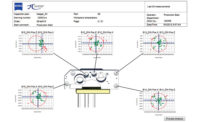NEW YORK, NY–Merger and acquisition (M&A) value increased 70% in the industrial manufacturing sector during the second quarter of 2011, according toAssembling Value, a quarterly analysis of M&A activity in the global industrial manufacturing industry by PwC US. In the second quarter of 2011, there were 46 deals that were worth more than $50 million with a total deal value of $18.6 billion, compared to 33 deals and $9.8 billion in the second quarter of 2010. Average deal value was relatively flat at $400 million in the second quarter of 2011 compared to the prior quarter and up from $300 million in the same period of 2010.
In the first six months of 2011, both deal volume and value were up with 86 deals-worth more than $50 million-and a total value of $35.9 billion, an 83% increase in volume and 197% increase in value when compared to the 47 deals worth $12.1 billion in the first six months of 2010.
“The maturity of the industry, a fairly high market concentration and favorable deal valuations were factors that drove and will continue to drive deal activity in the industrial manufacturing industry,” says Barry Misthal, global industrial manufacturing leader for PwC. “In the near-term, continuous global economic growth, fueled by emerging markets, greater capital availability, and more cash on balance sheets should continue to aid strong deal activity in the industrial manufacturing sector.”
“In fact, a recent survey we conducted with executives at large, multinational U.S. industrial manufacturing companies found that while a number of global factors contributed to the uncertainty about the world economy of late, U.S.-based industrial manufacturers continued to grow international sales last quarter and remain bullish on overseas revenues. In spite of the recent market volatility, PwC believes that the outlook for deals in the space is encouraging.”
In the second quarter of 2011, U.S.-affiliated transactions dominated M&A activity for deals worth more than $50 million, making up 41% of total deal volume and 66% of total deal value, with 19 deals with a total deal value of $12.3 billion.
Strategic investors continued to drive deal activity in the second quarter of 2011 with approximately 80 percent involved in deals worth more than $50 million, compared to nearly 20 percent from financial investors. In the first half of 2011, nearly 78% of strategic investors were involved in deals worth more than $50 million, already exceeding the involvement of strategic investors for all of 2010 with approximately 76 %.
“The mature and saturated nature of the industry is driving companies to seek growth opportunities through further consolidations within the industrial manufacturing sector,” Misthal says. “Even though financial and credit conditions have improved, financial investors have not yet made a strong return to this sector, and the slowdown that began during the second quarter of the year has negatively impacted financial investors’ interest.”
According to PwC, mega deal activity, or transactions worth $1 billion or more, was entirely driven by strategic investors in the second quarter of 2011, confirming the strong desire of these companies to realize growth through acquisitions. During the second quarter of 2011, there were three mega deals with a total value of $7.7 billion, compared to three mega deals worth $4.4 billion in the second quarter of 2010.
“Small and undisclosed value deals continued to dominate deal activity in the second quarter of 2011 as strategic and financial investors are approaching prospective transactions with increased caution. Although globalization remains relevant, companies are shifting their focus towards deals that can provide new strategic opportunities and synergistic growth,” Misthal continues. “Going forward, mega deal activity is expected to continue to be restrained by companies and financial investors’ conservatism in pursuing large transactions along with the growing uncertainty of the industrial manufacturing sector. However, despite the improving macro-economic conditions, companies are likely to continue to deleverage and invest in smaller, bolt-on acquisitions.”
For deals worth $50 million or more, the industrial machinery category was the primary driver of deal activity with 61% and one of the three mega deals in the second quarter of 2011. Despite contributing the remaining two mega deals, the number of rubber and plastics products deals decreased during the second quarter of 2011 with 4 deals worth $3.53 billion, compared with four deals worth $0.65 billion in the second quarter of 2010. Meanwhile, the number of fabricated metal products deals increased to 20% during the second quarter of 2011 from 12% in the same period of 2010.
The pace of global domestic market transactions has already exceeded all of 2010, which represented approximately 58% of deals worth more than $50 million, compared to nearly 72 % during the second quarter of 2011 and nearly 61% in the first half of 2011. According to PwC, companies are pursuing more local consolidations as growth tools, as both the emerging and some developed markets have already taken steps to restrain unsustainable growth in order to control inflationary pressures.
“As firms within the emerging markets grow and become financially stronger, they are likely to pursue opportunities within their local economies, since there is less risk in local transactions. Their economies’ growth is expected to surpass the growth in the developed world,” Misthal adds.
Global domestic deals across all regions led deal activity with North America contributing 13 deals and both Asia and Oceania and Europe contributing 10 deals. Interestingly, Asia and Oceania’s stake in total transactions decreased both in terms of volume and value during the second quarter of 2011 with 30%--or 14 deals worth more than $50 million, compared to 41%--or 11 out of 27 deals during the second quarter of 2010.
“North America and the United Kingdom and Eurozone are expected to continue to make significant contributions to deal activity as companies within those regions strive to generate growth and greater returns,” continues Misthal. “At the same time, due to greater expected growth opportunities and stronger economic recovery, companies in Asian markets, especially in China, are likely to seek consolidation in their own local markets.”
BRIC countries also experienced strong deal activity in the second quarter of 2011 with 10 deals worth $50 million or more, and China contributing eight deals worth $2.25 billion. According to PwC, due to the great amount of state-owned assets that are going public or restructuring to leverage public capital in China, transactions in the country are likely to increase as investors seek opportunities for greater returns. India and Russia also present great opportunities for new market entrance to foreign companies.
“Companies need to be aware that incidents of corruption and bribery are of significant concern when doing business in emerging markets such as India, Brazil, Mexico, Russia, Indonesia and Turkey,” adds Misthal. “In fact, the rate of bribery and corruption in the industrial manufacturing industry has increased sharply in recent years-and with the uptick in deal activities, companies need to mitigate the related risks.”
In the latestAssembling Value,PwC includes a special report titled, “Does your company’s M&A strategy mitigate corruption-related risk and cost?” that discusses the factors that companies need to consider when pursuing cross-border deals, including vetting third parties, determining the appropriate level of due diligence, and navigating disclosure requirements for certain resources like conflict minerals.
The industrial manufacturing industry has been identified as an area of increased risk for Foreign Corrupt Practices Act (FCPA) violations. Incidents of corruption and bribery often arise in this sector when companies deal with third parties, as suppliers have been known to deliberately substitute inferior materials to reduce costs.
According to Misthal, “Many industrial manufacturing companies are taking a zero-tolerance approach to bribery and corruption so as not to risk penalties from regulators and potential damage to brand value and share price. In response, companies are prioritizing anticorruption initiatives that mandate effective ‘tone at the top’ and are sending a consistent message opposing economic crime.”
For a copy ofAssembling ValuePwC’s quarterly analysis of M&A activity in the global industrial manufacturing sector, please visit:www.pwc.com/us/industrialproducts .
Get our new eMagazine delivered to your inbox every month.
Stay in the know with Quality’s comprehensive coverage of the manufacturing and metrology industries.
SIGN UP TODAY!Copyright ©2024. All Rights Reserved BNP Media.
Design, CMS, Hosting & Web Development :: ePublishing


